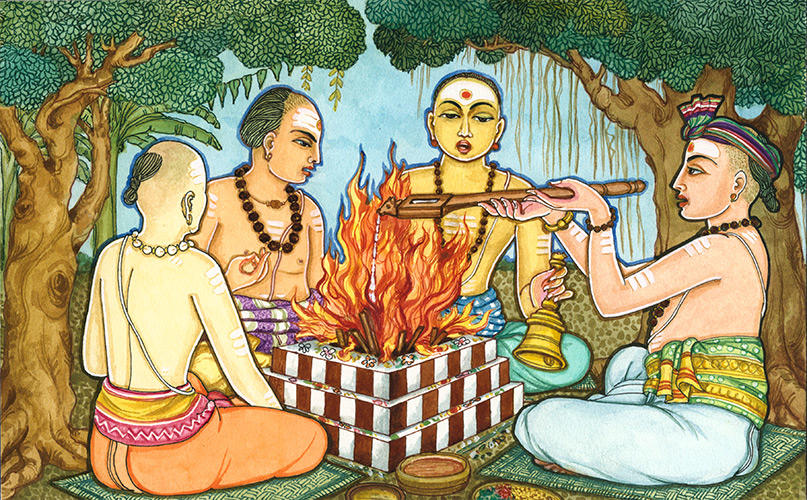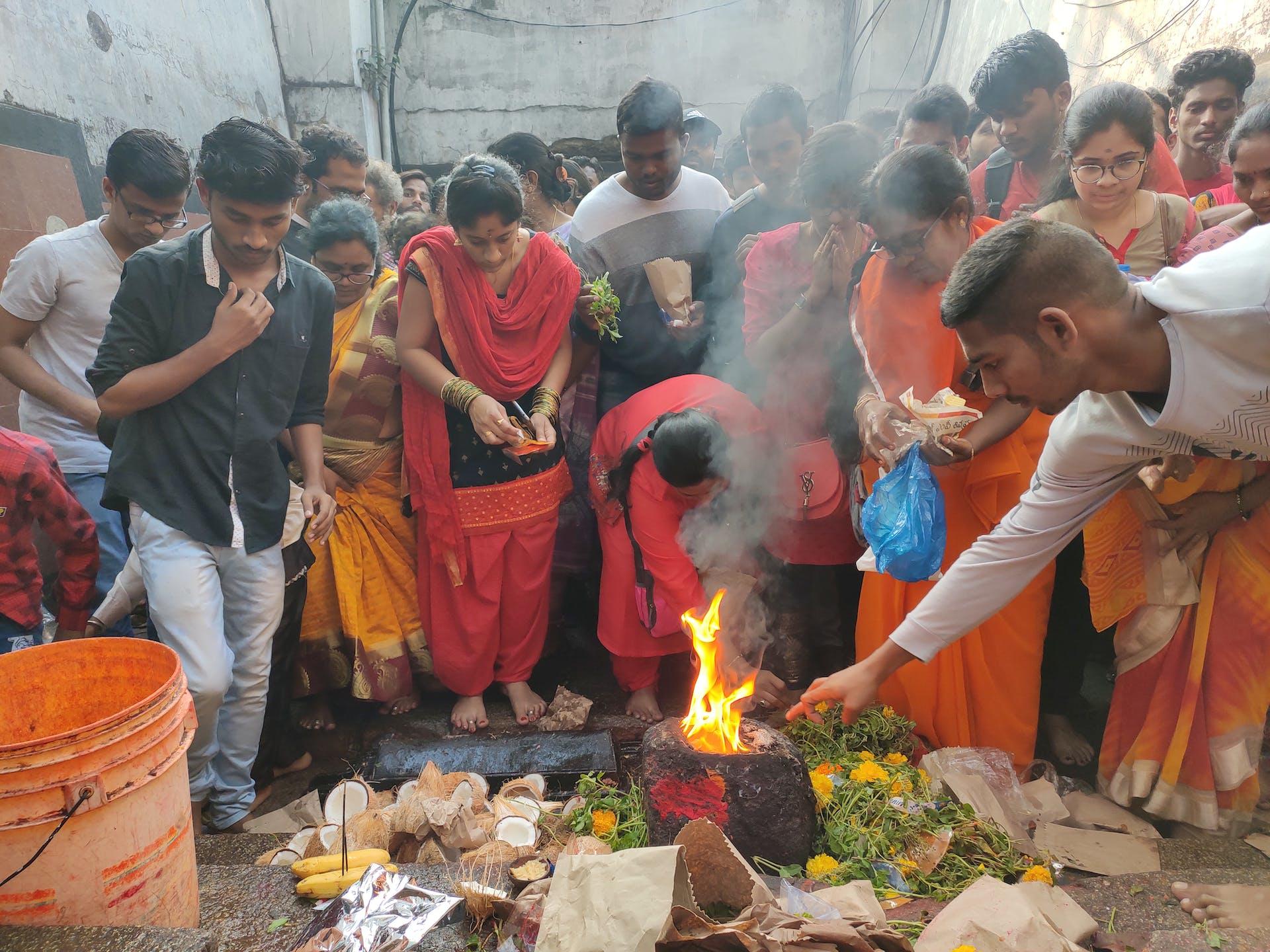The Yajurveda (also called Yajur Veda) is the third compilation in the collection of the four Vedas, after the foundational Rigveda and the learning-methodology-setting Samaveda.
It provides a comprehensive collection of rituals, mantras, and more for the all-important cultural and religious practices of ancient Indian peoples. And, it is still used today for such ceremonies, like weddings, funerals, births, and other events.
Let’s explore the history, structure, and influence of the Yajurveda on ancient and modern society!

What is the Yajurveda?
As you know, the Yajurveda is one of the four Vedas, which are the ancient texts that direct the spiritual and religious practices of Hinduism as well as Indian culture and society at large.
The Vedas were composed, in an entirely oral tradition, for hundreds or thousands of years before being written down. Rishis would meditate and receive more divine truths, which they would add to this massive verbal database, and they would transmit it to disciples and other Rishis only by speaking and memorizing.
Sometime around 1700 BCE and 900 BCE, Veda Vyasa, whose name was Krishna Dvaipayana, compiled the aural information into books so that more people could more easily learn and understand the information and wisdom in the Vedas.
The Yajurveda was designated the tome that would deal with ceremonies and rituals.
What Does “Yajurveda” Mean?
The word “Yajur” refers to yajus, which means practice or ritual. Veda means knowledge.
The Yajurveda is sometimes referred to as the Book of Rituals, since the title refers to that and the contents are dedicated to the realization of the power of practicing rituals.
Another name sometimes used for the Yajurveda is the Adhvaryuveda, because an adhvaryu is the title of the main chief priest who guides the entire performance of a sacrifice ritual.
The literal meaning of Yajurveda is "Knowledge of Rituals"
A Guidebook for Priests
While anyone can read and learn from this Veda, and all the Vedas, the target audience of this particular collection is mostly pandits and Purohits because they must be able to carefully follow these rituals with precision in their work.
The Yajur Veda deals with describing many different types of ceremonies and rituals, but the most important type of ritual is Yajna (aka Yagna, Havan, Homa) which is the fire sacrifice ritual.
In these rituals, the adhvaryu is the executive priest and recites from the Yajurveda while assigning duties to the yajamana (the ritual’s patron) and other priests.
The ritual or ceremony is typically performed in tandem with the Samaveda, which gives tones and rhythm to the chants and mantras.
Furthermore, the different mantras in the Yajurveda are meant to invoke specific deities for specific rituals and sacrifices.
History of the Yajurveda
The Yajurveda has a somewhat unique history compared to the other Vedas, resulting in two very distinct schools of thought and practice.
When Veda Vyasa set about compiling the Vedas, he also had four main disciples whose job it was to go forth and teach about their assigned Veda.
The disciple assigned to teach the Yajurveda was Rishi Vaishampayana. He began teaching the Veda to his own disciples, of which there may have been as many as 27, according to some sources.
One of the disciples was named Rishi Vajavalkya, and he was a very capable student.
The legend goes that one day Rishi Vaishampayana was meant to attend a conference about the Vedas, but something came up and he was unable to attend and also unable to inform the other Rishis at the conference that he would not be there; in short, he broke a promise, which was a sin.
He asked his disciples to perform a ceremony that would absolve the sin, and Vajavalkya was overly confident in his abilities, saying he alone should perform the ceremony since the other students weren’t advanced enough.

Vaishampayana didn’t like Vajavalkya’s hubris, so he exiled him from the school. Before he left, he had to give back (literally vomit) the knowledge he had collected under the tutelage of Rishi Vaishampayana. The legend says that Vajavalkya did so and the other disciples “turned into partridges (Taittiri birds) and gobbled up the vomited knowledge.
This version of Vajavalkya’s knowledge came to be known as Krishna Yajurveda.
He then left the school, having forgotten all that he had learned because he gave it all back, and began to meditate on Surya, the sun god, asking to become a Suryan disciple.
Surya is said to have appeared to Vajavalkya in the form of a horse or eagle and, accepting Vajavalkya as his disciple, re-taught the Yajurveda to him. Vajavalkya learned even more than before and eventually reorganized his knowledge, which became known as the Shukla Yajurveda.
Other Recensions of the Yajurveda
It is said that there were originally 101 recensions (versions or schools) of the Yajurveda, but today only two are known and practiced.
The Two Main Schools of the Yajurveda
These two schools – Krishna Yajurveda and Shukla Yajurveda – are the main organizational features of the Yajurveda today.
Krishna Yajurveda
The veracity of the tale of the origin of the Krishna Yajurveda is questioned among Vedic scholars, but there is usually a grain of truth in legends like these.
What may have happened is that Vajavalkya was expelled from the school and was required to “regurgitate” everything he knew, which may have been done in a disorganized manner and which the other disciples held on to in reverence.
In this context, Krishna is often translated as “dark” in English, and it refers to the disorganized manner of the knowledge, making it unclear and confusing.
The Krishna Yajurveda is a mixture of mantra and Brahmana (aka verse and ritual procedures). The organization makes it unclear which information is meant to be mantra and which is meant to be Brahmana; this is what is meant by Krishna: “dark.”
This version of the Yajurveda is of the Brahman school, meaning it is devoted mostly to Brahma.
There are even recensions of this branch of Yajurveda. Originally, Krishna Yajurveda had 85 schools (called Shakhas), but today there are only four, and the most important one is called Taittirya Shakha.
Shukla Yajurveda
Just like the origin of the Krishna Yajurveda, the origin of the Shukla Yajurveda is questionable.
What may have happened is that Vajavalkya left the school of Vaishampayana and continued to study and refine his knowledge on his own.
Claiming to have received the information from a divine entity would certainly excuse Vajavalkya from trouble for continuing his studies even though he wasn’t supposed to!
This also may be the explanation as to why this new version of the Yajurveda is of the Aditya school, meaning it is devoted mostly to the solar god (aka Surya).
This newer version of the Yajurveda is much more organized, clearly separating the mantra from Brahmana. This is why it is called “light” or “bright” in English.
In this context, Shukla means illuminated, clear, and organized.
There were once 17 Shakhas of the Shukla Yajurveda, but now there are only two. The most important one is called Vajasaneyi Shakha.
| Krishna Yajurveda | Shukla Yajurveda |
|---|---|
| Brahma-school | Aditya-school |
| Compiled 1st | Compiled 2nd |
| “Dark” in English | “White” or “light” in English |
| Unclear, disorganized, mantra and Brahmana are mixed together | Clear, organized, mantra and Brahmana are clearly separated |
| Contains less information | Contains more information |
| Mostly practiced in South India | Mostly practiced in North India |

Structure of the Yajurveda
The Yajurveda contains both prose and verse, meaning it has informational text as well as poetic hymns. The prose is called Yajush, and the verse is called Mantra.
It contains about 1875 verses that are borrowed from the Rigveda, but they are built upon in a distinct way in the Yajurveda. The Yajurveda also shares some mantras with the Atharvaveda.
Since the two schools of the Yajurveda – Krishna and Shukla – are so prominent, you can’t talk about one without the other. There is no over-arching Yajurveda that can be talked about instead. This makes understanding the structure of the Yajurveda very complicated!
But, I have tried to simplify it as much as possible here in this guide for ease of understanding.
Typical Veda Structure
All the Vedas are made up of four subdivisions: Samhita, Brahmana, Aranyaka, and Upanishad.
Mostly, we learn about the Samhitas and the Upanishads.
The two schools of the Yajurveda each have their own subdivisions.

Structure of Krishna Yajurveda
The Shakhas of the Krishna Yajurveda are the same as its Samhitas. They are:
- Taittiriya Samhita
- Kathaka Samhita
- Kapishthala Samhita
- Maitrayani Samhita
The most prominent, the Taittiriya Samhita, contains 7 kandas, 44 prapathakas, 631 anuvakas and 2198 mantras or kandikas.
The Krishna Yajurveda has one Brahmana, called Taittiriya Brahmana, and one Aranyaka, called Taittiriya Aranyaka.
There are 32 Upanishads in the Krishna Yajurveda, and the principal ones are:
- The Taittiriya Upanishad
- The Katha Upanishad
- The Svetasvatara Upanishad
- The Matrayania Upanishad
Structure of Shukla Yajurveda
The Shakhas of the Shukla Yajurveda are the same as its Samhitas. They are:
- Madhyandina Samhita
- Kanva Samhita
The Madhyandina Samhita contains 40 chapters, 303 anuvakas and 1975 mantras or kandikas. The Kanva Samhita contains 40 chapters, 328 anuvakas and 2086 mantras or kandikas.
Remember that the Shukla Yajurveda contains more information than the Krisha Yajurveda. Many scholars consider only the first 25 chapters (out of 40) to be Apaurusheya, meaning actual divine wisdom, and some only consider the first 18 chapters.
Because the remaining chapters are written in a different style, many scholars believe the information in those chapters is Paurusheya, meaning knowledge that was concluded after being thought about by a human - that is to say, not divine knowledge.
The Brahmana for the Shukla Yajurveda is called Satapatha Brahmana, which has an additional two recensions: the Kanva Shakha and the Madhyandina Shakha.
There is no known Aranyaka at this time.
The Shukla Yajurveda has 19 Upanishads, and the most important are:
- The Brhadaranyaka Upanishad
- The Isha Upanishad
Rituals in the Yajurveda
Some of the rituals and yajnas described in the Yajurveda include:
- Darśapurṇamāsa
- Aśvamedha
- Rājasuya
- Śautrāmaṇi
- Vājapeya
- Amavashya
- Purnima
- Agnihotra
The Yajurveda describes the factors that influence which rituals to perform, as well as when and how.
- Timings relating to celestial bodies, seasons, and days of the week
- Timings based on the stage of life
- What sacrifices to offer to the fire
- What mantras to recite
- What instruments (musical or yantra) to use
The vast majority of the Yajurveda is dedicated to describing every detail needed to perform specific rituals, making it an extremely comprehensive guidebook.
May my rice plants and my barley, and my beans and my sesame,
Shukla Yajurveda 18.12.
and my kidney-beans and my vetches, and my pearl millet and my proso millet,
and my sorghum and my wild rice, and my wheat and my lentils,
prosper by sacrifice.
Modern Influence of the Yajurveda
Beyond ritual and ceremonial information, the Yajurveda has also provided valuable anthropological and historical information about life at the time it was written.
It describes the Varna (Caste) system and mentions many tribes and geographical locations in ancient India.
It also defines certain aspects of music and writing, like udata, anudata, and swarita.
While some of the cultural aspects described in the Yajurveda are outdated and not typically followed anymore, it still influenced culture up to the present, so echoes of this ancient way of life are still evident in the modern day.
Popular Mantras in the Yajurveda
The mantras and ceremonies described in the Yajurveda are still very much used today for devotion, meditation, and in the intended way as a ritual.
One of the most popular mantras, “Sri Rudram Namakam Chamakam” is contained only within the Yajurveda.
Some lessons we can take wholeheartedly from Yajurveda are that one should have deep love for their friends, foster the feeling of universal brotherhood, and generosity towards everyone.
The Yajurveda is a complex tome in both structure and scripture, but that doesn’t mean you shouldn’t try to learn from it!
References
- Hindupedia, the Hindu Encyclopedia. “Yajurveda.” Hindupedia, the Hindu Encyclopedia, 14 June 2023, hindupedia.com/en/Yajurveda.
- Skree. “The Vedas – Origin and Brief Description of 4 Vedas.” 108 House, 18 Oct. 2021, www.108.house/the-vedas-origin-and-brief-description-of-4-vedas/.
- “Veda Vyasa: The Sage Who Compiled the Vedas.” Hindu American Foundation, 21 Sept. 2020, www.hinduamerican.org/blog/veda-vyasa-the-sage-who-compiled-the-vedas.
- “What Is Yajur Veda?” Yogapedia.Com, www.yogapedia.com/definition/8040/yajur-veda.
- “Yajurveda English.” Mahakavya, 4 Apr. 2023, www.mahakavya.com/yajurv-veda-english/.
- “Yajurveda.” Vedic Heritage Portal, vedicheritage.gov.in/samhitas/yajurveda/.“Yajurveda: Vedic Texts of Hindu Religion.” Hinduism4u.Com, 2 Apr. 2023, hinduism4u.com/yajurveda/.











